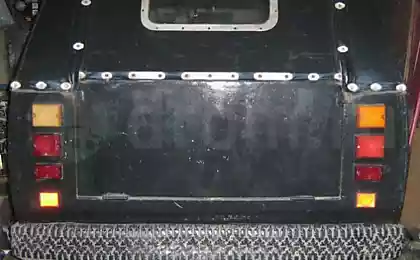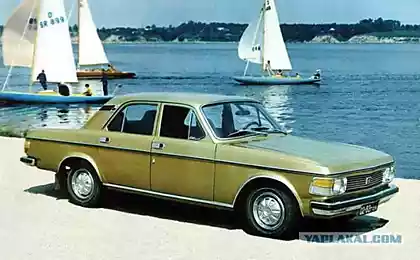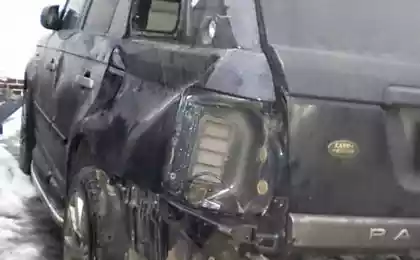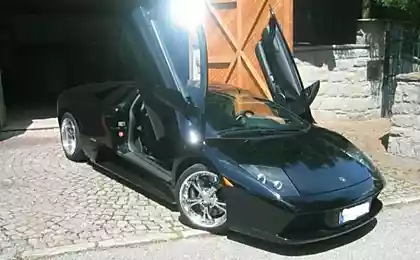454
Catecar has brought to Geneva its vision of the environmentally friendly car
The number of dragonflies, as trademarks for automobiles, has increased. We already know about Chinese companies Qiantu, chose the logo of his electric sports car K50 Event the image of a dragonfly. Drawing of the same insect struck on the grille of his concept of Catecar, the Swiss company.

At the Geneva motor show this year was presented a sufficient number of electric cars from leading manufacturers. Most of them are designed for the premium segment and the main emphasis was placed on design, power, speed. But there were other decisions, the time for which the journalists covering this event usually was.
Catecar was interesting-in hybrid electric vehicle with solar panels, which is designed to solve such problems as climate change and rising energy prices.

The philosophy underlying this machine takes us to the prehistoric dragonfly that had a wingspan of 74 cm (29 inches), but over time this insect has decreased in size, as scientists assume, due to loss of oxygen. In other words, it reduced their "power."
In the design of road Dragonfly attended the Swiss Federal institutes of technology in Lausanne and Zurich. It weighs 560 kg (1,234 lb), and one hour of sunlight can provide him with 4 km (2.5 miles) movement from the solar panels — the roof of the car generates 300W per hour of energy from the sun.
Dragonfly has an aluminum frame. It is the job of Beta Epsilon from Le Mans.
The body of the car made by the company Bcomp SA specializing in natural fiber composites one of its leading products is PowerRibs ® is a patented reinforcement technology of flax. The advantages of this material are: lightness, stability, biological degradability, it is easily formed. At the International motor show in Geneva, the model shows bare composite frame on the front fenders.
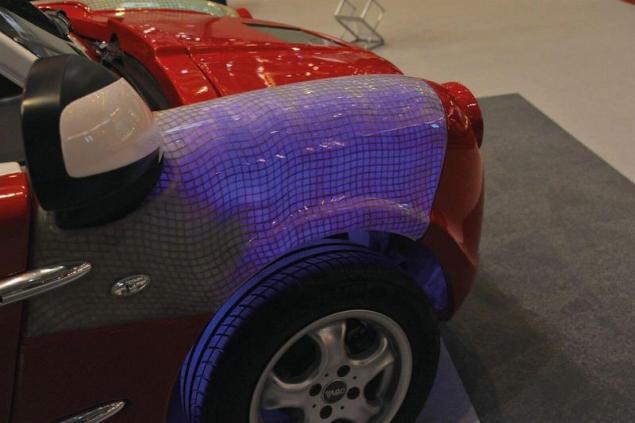
The solar roof is the result of research and development Swiss Federal Institute of technology in Lausanne. The task was to get the maximum energy on a limited surface area. Currently the cost of solar panels has been steadily declining with the growth of energy efficiency. Responsible for the integration of this technology in the Dragonfly in the first round of production was the company Bluebird Photovoltaics Ltd., which develops and produces original panel with tested and proven durability.
The company's goal was to make as independent network car and get a car with the autonomy of 1,000 km (621 mile), regardless of the weather conditions thanks to the gasoline range extender that can recharge the batteries if necessary, if there will not be a charger.
Drive system the following: a motor with a capacity of 7 or 11 kW depending on modifications; the battery pack, the capacity of which Catecar has not been disclosed. The only condition that it agrees to comply with is the weight of the vehicle — it should be no more than 100 kg.
Also Dragonfly is equipped with engine capacity of 10 kW connected to a generator.
Perhaps the most surprising decision in electric mobility is an active system for continuous air filtration.

This is the device that best illustrates the philosophy of Catecar, as President of this group, Henri-Philippe Sambuc:
"It is unnecessary to try to compare Dragonfly and Mercedes. In the car, which we represent, counters, watt and smaller particles are more important than the speedometer and rpm . This is done in order to become part of the solution to the problem of air pollution fine particles and CO2. In minimizing harmful emissions and continuous cleaning of the atmosphere, the Dragonfly is actively involved in saving the planet. Air pollution and global warming could have dramatic consequences for health. Our device is located directly behind the grille, is the latest generation of air filter, fine clean particles (ISO 16890). It is capable of processing from 30 to 100 m3 of air, which corresponds to a clearance of 3 to 12 apartments of 75 m2 each day "by the Way, these filters can be installed on any car and manufacturing company is primarily.
The final price for this hybrid electric vehicle has not yet named (about 20 000 Euro), but the company has already opened pre-orders on its website. As soon as we have sufficient to start the production of machinery orders Catecar promises to open a production line.
Approval Catecar, she's going to build a business model that allows us to produce cars in cooperation with local partners in different countries, seeking to invest in a new kind of mobility, and this requires only minor investment costs. published
P. S. And remember, only by changing their consumption — together we change the world! ©
Source: www.electromobile360.ru/2017/03/catecar.html

At the Geneva motor show this year was presented a sufficient number of electric cars from leading manufacturers. Most of them are designed for the premium segment and the main emphasis was placed on design, power, speed. But there were other decisions, the time for which the journalists covering this event usually was.
Catecar was interesting-in hybrid electric vehicle with solar panels, which is designed to solve such problems as climate change and rising energy prices.

The philosophy underlying this machine takes us to the prehistoric dragonfly that had a wingspan of 74 cm (29 inches), but over time this insect has decreased in size, as scientists assume, due to loss of oxygen. In other words, it reduced their "power."
In the design of road Dragonfly attended the Swiss Federal institutes of technology in Lausanne and Zurich. It weighs 560 kg (1,234 lb), and one hour of sunlight can provide him with 4 km (2.5 miles) movement from the solar panels — the roof of the car generates 300W per hour of energy from the sun.
Dragonfly has an aluminum frame. It is the job of Beta Epsilon from Le Mans.
The body of the car made by the company Bcomp SA specializing in natural fiber composites one of its leading products is PowerRibs ® is a patented reinforcement technology of flax. The advantages of this material are: lightness, stability, biological degradability, it is easily formed. At the International motor show in Geneva, the model shows bare composite frame on the front fenders.

The solar roof is the result of research and development Swiss Federal Institute of technology in Lausanne. The task was to get the maximum energy on a limited surface area. Currently the cost of solar panels has been steadily declining with the growth of energy efficiency. Responsible for the integration of this technology in the Dragonfly in the first round of production was the company Bluebird Photovoltaics Ltd., which develops and produces original panel with tested and proven durability.
The company's goal was to make as independent network car and get a car with the autonomy of 1,000 km (621 mile), regardless of the weather conditions thanks to the gasoline range extender that can recharge the batteries if necessary, if there will not be a charger.
Drive system the following: a motor with a capacity of 7 or 11 kW depending on modifications; the battery pack, the capacity of which Catecar has not been disclosed. The only condition that it agrees to comply with is the weight of the vehicle — it should be no more than 100 kg.
Also Dragonfly is equipped with engine capacity of 10 kW connected to a generator.
Perhaps the most surprising decision in electric mobility is an active system for continuous air filtration.

This is the device that best illustrates the philosophy of Catecar, as President of this group, Henri-Philippe Sambuc:
"It is unnecessary to try to compare Dragonfly and Mercedes. In the car, which we represent, counters, watt and smaller particles are more important than the speedometer and rpm . This is done in order to become part of the solution to the problem of air pollution fine particles and CO2. In minimizing harmful emissions and continuous cleaning of the atmosphere, the Dragonfly is actively involved in saving the planet. Air pollution and global warming could have dramatic consequences for health. Our device is located directly behind the grille, is the latest generation of air filter, fine clean particles (ISO 16890). It is capable of processing from 30 to 100 m3 of air, which corresponds to a clearance of 3 to 12 apartments of 75 m2 each day "by the Way, these filters can be installed on any car and manufacturing company is primarily.
The final price for this hybrid electric vehicle has not yet named (about 20 000 Euro), but the company has already opened pre-orders on its website. As soon as we have sufficient to start the production of machinery orders Catecar promises to open a production line.
Approval Catecar, she's going to build a business model that allows us to produce cars in cooperation with local partners in different countries, seeking to invest in a new kind of mobility, and this requires only minor investment costs. published
P. S. And remember, only by changing their consumption — together we change the world! ©
Source: www.electromobile360.ru/2017/03/catecar.html



